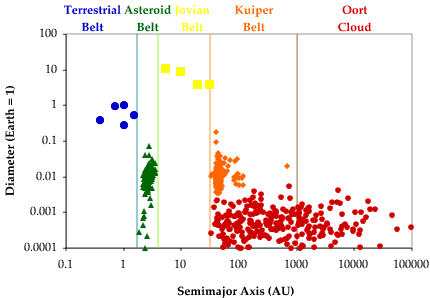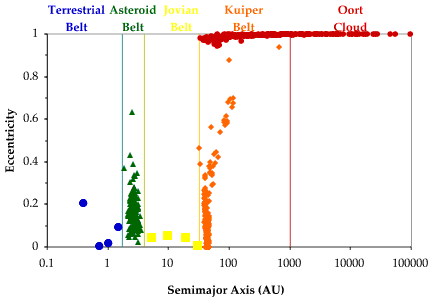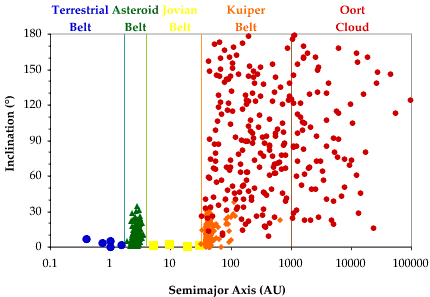21.2 An Overview of the Solar System
(Discovering the Universe, 5th ed., §II.4, §II.5)
- To understand how our Solar System came into existence, it is first helpful to study the basic characteristics of the objects that inhabit it: average distance from the Sun (semimajor axis), diameter, density, eccentricity, and orbital inclination.
These characteristics help us categorize these Solar System objects into a few small groups.
- Astronomers early on determined the semimajor axis of solar system objects.
With telescopes, the diameters of the larger objects are visible and can also be measured.
For smaller objects, diameter is often estimated based on their measured brightness and assumptions about the fraction of sunlight they reflect, known as their albedo.
By comparing these two characteristics, semimajor axis and diameter, we can identify five basic groups of objects in the solar system:

- The Jovian planets are the largest objects, on the order of 10 times the size of the Earth, and are so-called because they all have basic similarities to Jupiter (also known as Jove).
The Jovian planets are, inclusively, Jupiter, Saturn, Uranus, and Neptune.
The region where the Jovian planets orbit, between 5 A.U. and 30 A.U., is called the Jovian Belt.
- The terrestrial planets are so-called because they all have basic similarities to the Earth.
The terrestrial planets are, inclusively, Mercury, Venus, the Earth, the Moon, and Mars.
The region where the terrestrial planets orbit, between 0 A.U. and 1.5 A.U., is called the Terrestrial Belt.
- The asteroids are significantly smaller than the terrestrial planets, on the order of 1/10 to 1/100 of the size of the Earth, and are therefore called minor planets.
The name asteroid comes from the fact that they are so small that they didn't show a disk in early telescopes, and were therefore "star-like".
The three largest asteroids are Ceres, Pallas, and Vesta.
More than 10,000 other asteroids have been identified.
The region where most of the asteroids orbit, between 1.7 A.U. and 3.5 A.U., is called the Asteroid Belt.
- The distant icy asteroids are similar in size to the asteroids, and are also called minor planets.
Note that the smallest "planet", Pluto, is categorized here as an icy asteroid, though so far as we know it's the largest of them.
Extra: this classification of Pluto is not "official"; read the International Astronomical Union's press release on the subject.
Discovered in 2004, Sedna is the second largest icy asteroid known, at roughly two thirds the diameter of Pluto.
Sedna is followed closely in size by Quaoar and then by Pluto's own moon Charon.
Except for Pluto (1930) and Charon (1978), all of the more than 500 icy asteroids known have been discovered since 1992.
The region where most of the icy asteroids orbit, between 30 A.U.and 1000 A.U., is called the Kuiper Belt, after Gerard Kuiper, the astronomer who proposed its existence in 1951.
The icy asteroids are commonly known amongst astronomers as Kuiper Belt objects (KBOs) or trans-Neptunian objects (TNOs).
- Comets are the smallest objects, on the order of 1/1000 to a 1/10,000 of the size of the Earth, though they sometimes approach the Earth and become very bright.
Famous examples of comets include Halley, Hale-Bopp, and Shoemaker-Levy 9.
The region where most of the comets orbit, between 1000 A.U. and 100,000 A.U., is called the Oort Cloud, after Jan Oort, the astronomer who proposed its existence in 1950.
A signficant number of comets can also be found in the Kuiper Belt, though as we will see they are physically distinct from the icy asteroids.
- We can gain more understanding and distinction of these classes by considering their mass, or more usefully, density.
Applying Kepler's and Newton's Laws allow the determination of planetary mass, and by combining with diameter, their density:

Distinct grouping are again visible on this chart.
It's useful to compare these numbers with the density of various materials:
| Iron and other dense metals such as nickel, lead, etc.: |
>~ 8 g/cm3 |
| Rock and light metals such as aluminum: |
~ 3 glcm3 |
| Water and other liquids/ices such as methane and ammonia: |
~ 1 glcm3 |
| Compressed gas such as hydrogen, helium, etc. (highly variable): |
<~ 0.1 g/cm3 |
The terrestrial planets are the densest objects, with densities suggesting they are mixtures of iron or other metals and rock.
The asteroids have similar or smaller densities; the densest appear to be pure metal, the least dense appear to be loose piles of rock (they are not large enough for their gravity to hold onto any gas).
The icy asteroids have lower densities than the other asteroids, suggesting they may be rock covered with ice (hence their designation).
The comets have the lowest densities, indicating they are mostly ice.
The Jovian planets also have very low densities, suggesting a large liquid and gaseous composition.
- Spectroscopic measurements of sunlight reflected by these objects have helped to confirm these compositions.
If a dark line appears in the reflected light that isn't in the Sun's spectrum (usually because it is molecular), it must be due to absorption by the planet's atmosphere or surface.
Question: how else might we determine the composition of these objects? To which does that apply?
- Eccentricity again helps to distinguish these objects from each other:

Eccentricity is relatively small for the terrestrial and Jovian worlds.
It is typically much larger for the asteroids and icy asteroids.
It is generally the maximum for the comets (possibly because these are only the ones we can observe).
- Orbital inclination is another distinguishing characterisitic:

An angle less than 90° indicates motion around the Sun in the same direction as the Earth.
An angle greater than 90° indicates motion in the opposite direction to the Earth, which is called a retrograde orbit.
Orbital inclination is relatively small for the terrestrial and Jovian worlds, all being relatively close to the ecliptic and in the same direction as the Earth.
It is typically larger for the asteroids and icy asteroids, but still less than about 30°, and again in the same direction as the Earth.
It is every possible angle for the comets, often opposite to the direction of the Earth, a random distribution of orbits.
- We can summarize these characteristics as follows:
| Object |
Semimajor Axis |
Diameters |
Densities |
Eccentricities |
Inclinations |
| Terrestrial Planets |
0 A.U. to
1.5 A.U. |
Medium |
High |
Small |
Small |
| Asteroids |
Mostly between
1.7 A.U. to
about 3.5 A.U. |
Small |
Mostly Medium |
Small to
Medium |
Small to
Medium |
| Jovian Planets |
About 5 A.U. to
about 32 A.U. |
Large |
Very
Small |
Small |
Small |
| Icy Asteroids |
Mostly between
32 A.U. to
about 1000 A.U. |
Small |
Mostly
Small |
Small to
Medium |
Small to
Medium |
| Comets |
Mostly between
32 A.U. to
about 100,000 A.U. |
Very
Small |
Very
Small |
Large |
Small to
Large |
|